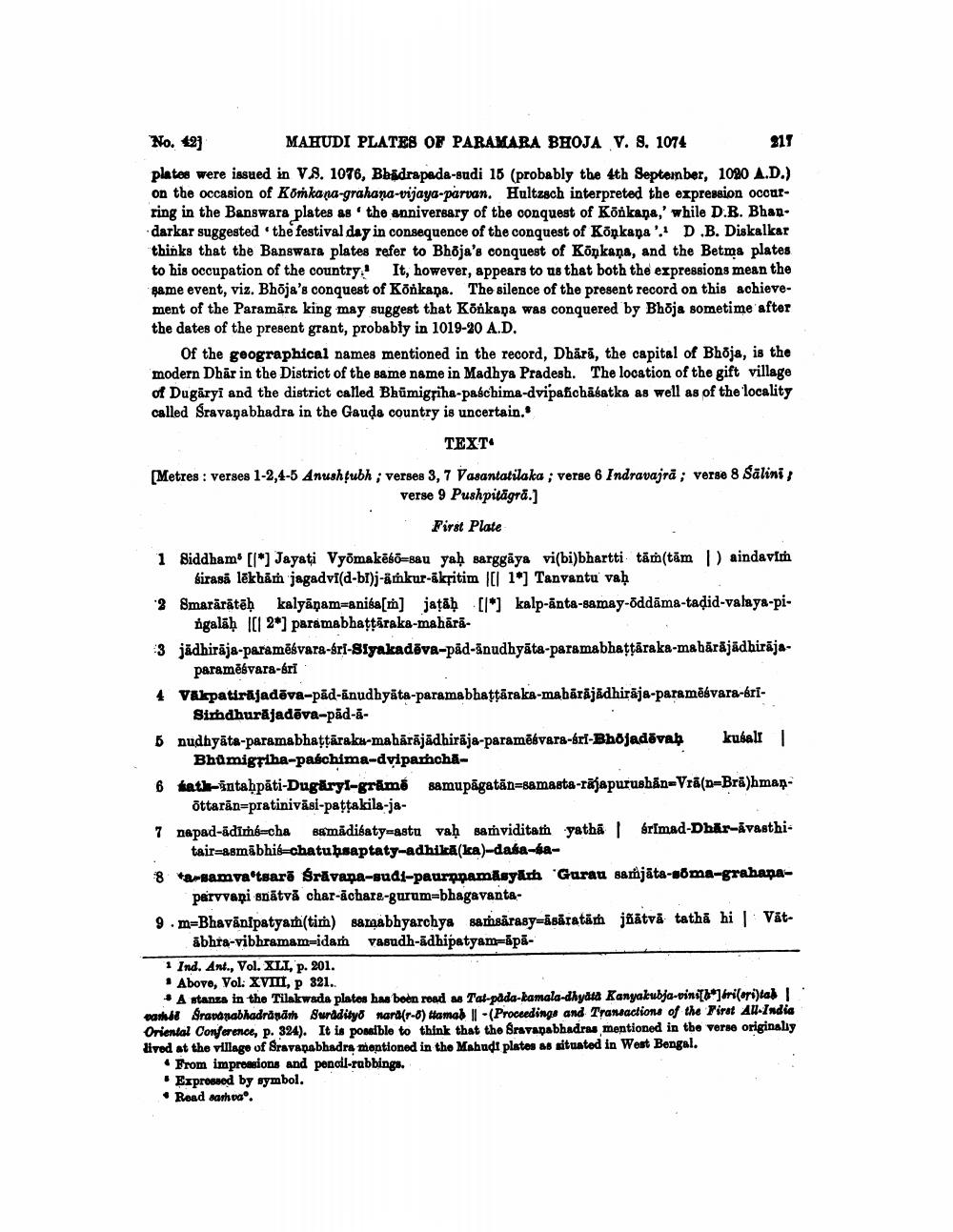________________
No. 42] MAHUDI PLATES OF PARAMARA BHOJA V. 8. 1074
911 plates were issued in V8. 1076, Bhadrapada-sudi 15 (probably the 4th September, 1020 A.D.) on the occasion of Kornkana-grahana-vijaya-parvan. Hultzsch interpreted the expression occurring in the Banswara plates as the anniversary of the conquest of Konkana,' while D.B. Bhar. darkar suggested the festival day in consequence of the conquest of Köņkapa'. D.B. Diskalkar thinks that the Banswara plates refer to Bhoja's conquest of Könkana, and the Betma plates to his occupation of the country' It, however, appears to us that both the expressions mean the game event, viz. Bhöja's conquest of Konkana. The silence of the present record on this achievement of the Paramärk king may suggest that Könkana was conquered by Bhöja sometime after the dates of the present grant, probably in 1019-20 A.D.
of the geographical names mentioned in the record, Dhärā, the capital of Bhoja, is the modern Dhär in the District of the same name in Madhya Pradesh. The location of the gift village of Dugăryi and the district called Bhūmigpiha-paschima-dvipafichābatka as well as of the locality called Sravanabhadra in the Gauda country is uncertain.
TEXT
[Metres : verses 1-2,4-5 Anushţubh ; verses 3, 7 Vasantatilaka ; verse 6 Indravajra; verae 8 Salini
verse 9 Pushpitāgrā.]
First Plate 1 Siddham [l*] Jayati Vyömakēbo=Bau yaḥ sarggāya vi(bi)bhartti täm(tām aindavim
sirasā lēkhām jagadvi(d-bi)j-ánkur-ākritim [] 1*] Tanvantu vaḥ 2 Smarärātēḥ kalyāṇam=anisa[m] jațāḥ [[*] kalp-anta-samay-oddāma-tadid-valaya-pi
ngalāḥ 1[1 2*] paramabhattāraka-mahārā. 3 jādbirāja-paramēšvara-sri-Slyakadēva-pād-anudhyāta-paramabhasțāraka-mabārājādbirāja
paramēsvara-bri 4 Vakpatirājadēva-päd-änudbyäta-paramabhatýāraka-mahārājādhirāja-paramēsvara-bri
Simdhurājadēva-pád-.6 nudhyāta-paramabhatýāraku-mahārājādbirāja-paramēsvara-bri-Bhöjadēvah kusali
Bhumigriha-paschima-dvipancha6 kath-intahpāti-Dugăryl-gramo samupāgatān=samasta-rajapurushän-Vrā(n-Brā)hmap
ottarān=pratinivāsi-pattakila-ja7 napad-ādimscha Bamádibaty=astu vaḥ samviditam yatha | Srimad-Dhar-āvasthi
tair=asmābhit-chatuḥsaptaty-adhikā(ka)-data-sa8 arbamvatsarā śrävapa-sudi-paurppamäsylith 'Gurau samjāta-ama-grahapa
parvvapi snätvå char-āchare-gurum=bhagavanta9.m=Bhavānipatyam(tim) samaabhyarchya samsārasy=āsäratām jñātvă tathā hi Vät
abhra-vibhramam-idam Vasudh-adhipatyam-ap1 Ind. Ant., Vol. XLI, p. 201.
Above, Vol. XVIII, P 321.. • A stangs in the Tilakwada plates has been road as Tal-pada-kamala-dhyata Kanyakubja-vinilb*]brilori)tab eash Sravanabhadranath Suradityo Hard(T-0) ttamal || -(Proceedings and Transactions of the First All-India Oriental Conference, p. 324). It is pomalble to think that the Sravanabhadras mentioned in the verse originally lived at the village of Sravanabhadra montioned in the Mahudi plates as situated in West Bengal.
From imprensions and pencil-rubbings. Expressed by symbol. • Read sathua




